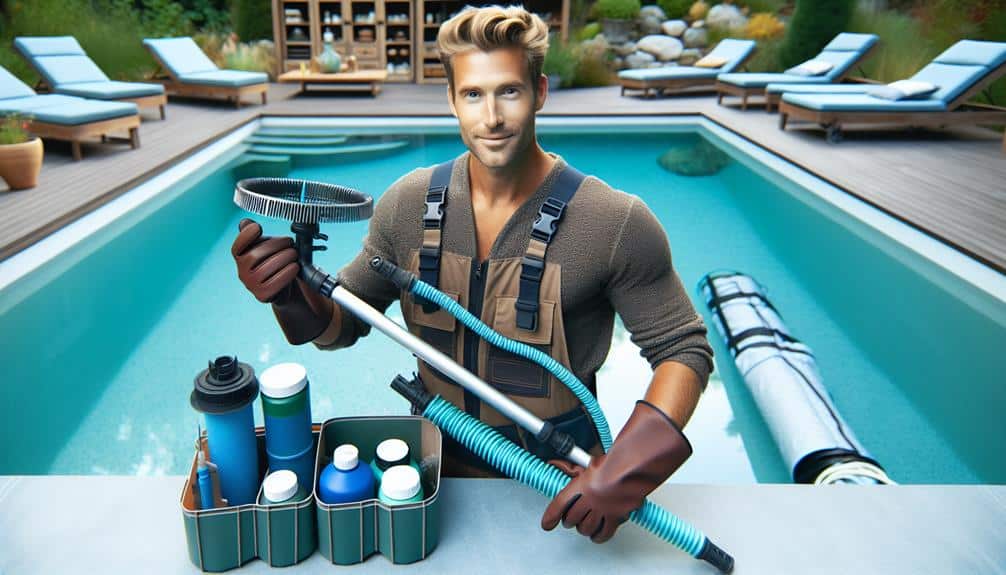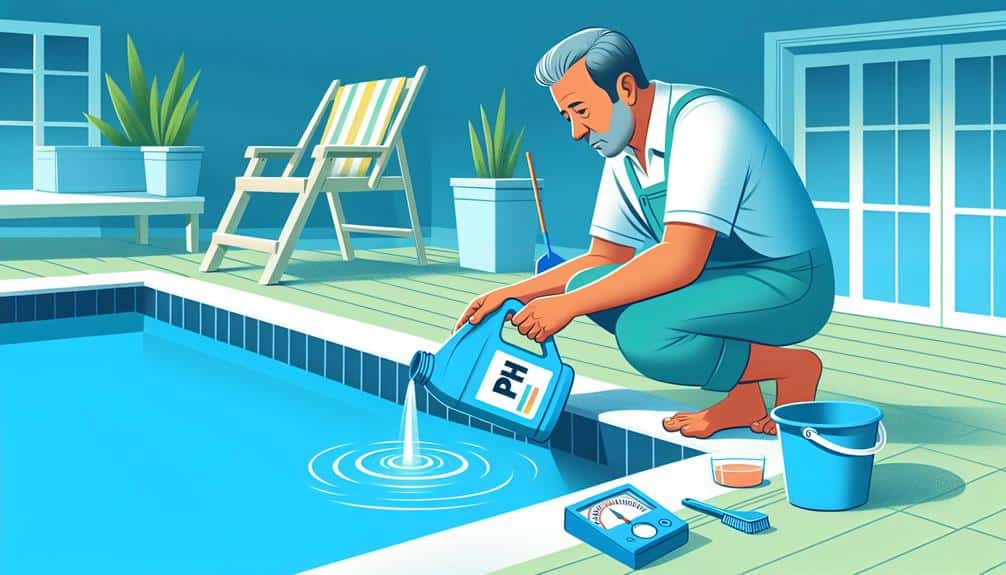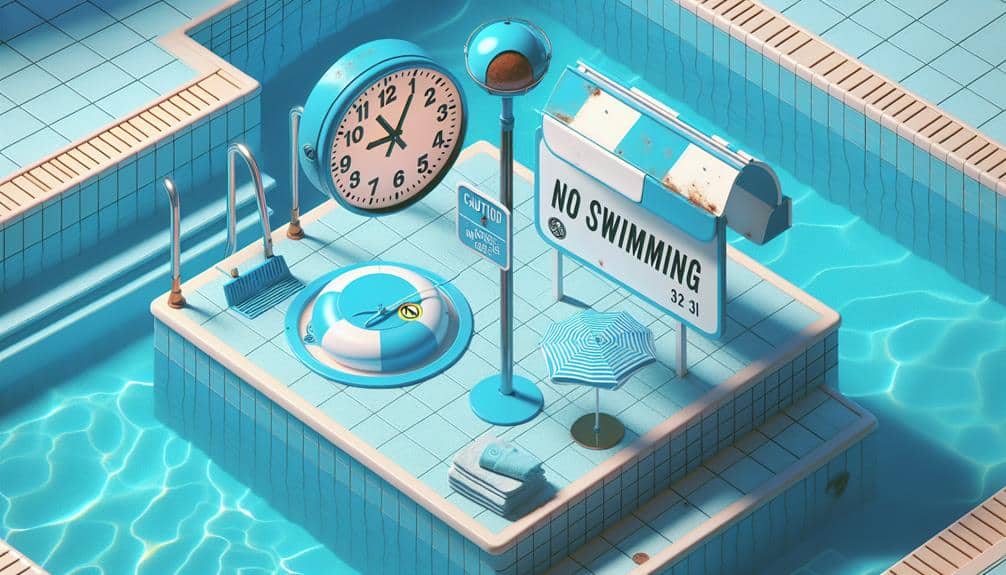When it comes to closing your swimming pool for the winter, there are several crucial steps you shouldn’t overlook. From draining the water to meticulously cleaning the pool surfaces and balancing the water chemistry, each task plays a vital role in preparing your pool for the colder months ahead. But, there’s one particular step that often gets underestimated, a step that could save you a lot of hassle and money down the line. So, let’s talk about the importance of inspecting your pool for potential issues before you bid it farewell for the season.
Drain the Pool Water
To drain the pool water efficiently, start by locating the drainage valve near the bottom of the pool. Before beginning the drainage process, ensure that the water is clean and free of debris to prevent clogging. Once you have located the drainage valve, attach a hose securely to the valve to direct the water to the desired location for disposal.
When it comes to water drainage techniques, remember to open the valve slowly to control the flow of water. Gradually release the water to avoid causing any damage to the pool or surrounding area. Keep an eye on the progress to ensure the water is draining smoothly without any issues.
As for pool water disposal options, you can consider options such as directing the water to a safe drainage area on your property, using it for irrigation if it’s chemically balanced, or contacting a professional service for proper disposal. Choose the method that aligns with local regulations and environmental guidelines for responsible pool maintenance.
Clean the Pool Surfaces
Before closing your swimming pool, make sure to brush the pool walls and skim off any debris floating on the surface. This step will help prevent algae growth and keep your pool clean during the off-season.
Regular maintenance now will save you time and effort when you reopen your pool.
Brush Pool Walls
Brushing the pool walls regularly helps keep the surfaces clean and free of algae and debris. Proper brush maintenance is crucial for effective wall scrubbing techniques. Make sure to use a brush specifically designed for your pool surface type to avoid damage.
Start at the waterline and work your way down, using firm and overlapping strokes. Pay extra attention to corners and crevices where algae tend to accumulate. Brushing should be done at least once a week during the swimming season to prevent buildup.
After brushing, remember to rinse the brush thoroughly with clean water and store it in a dry place to prevent mold or mildew growth. Proper maintenance of your brush will ensure its longevity and effectiveness.
Skim Debris
Skim the pool surfaces regularly to remove debris and maintain a clean swimming environment. Use a skimmer net to skim leaves, bugs, and other floating debris off the water’s surface. By clearing debris promptly, you prevent it from sinking to the pool bottom, making it harder to clean later.
Pay special attention to corners, steps, and around ladders where debris tends to accumulate. Skimming not only keeps the pool looking tidy but also helps maintain proper water circulation and filtration.
Aim to skim the pool at least once a day, especially during the fall when leaves are abundant. This simple task will go a long way in keeping your pool clean and inviting for a refreshing swim.
Balance the Water Chemistry
Before closing your swimming pool, ensure to test the water quality and adjust the chemical levels accordingly.
This step is crucial in maintaining the water’s clarity and preventing any potential issues during the off-season.
Test Water Quality
To ensure the safety of swimmers, regularly test the water quality and balance the chemistry in your swimming pool. Testing pH levels is crucial as it indicates the acidity or alkalinity of the water. The ideal range for pH in a pool is between 7.2 and 7.6.
Monitoring chlorine levels is also essential to keep the water sanitized and free of harmful bacteria. The recommended chlorine level for a pool is typically between 1.0 and 3.0 parts per million (ppm).
Adjust Chemical Levels
Maintaining proper chemical levels in your swimming pool is vital for ensuring a safe and clean environment for swimmers. When closing your pool, it’s crucial to adjust the chemical levels correctly. Here are some key steps to balance the water chemistry effectively:
- Check Chlorine Levels: Ensure the chlorine level is within the recommended range to prevent bacteria and algae growth.
- Monitor pH Balance: Keep an eye on the pH balance to avoid skin and eye irritation.
- Adjust Alkalinity: Maintain proper alkalinity levels to prevent pH fluctuations.
- Consider Calcium Hardness: Check and adjust calcium hardness to protect your pool equipment.
- Use Pool Stabilizer: Add stabilizer to help maintain chlorine levels longer, especially during the off-season.
Remove and Store Accessories
Gather all pool accessories, such as ladders and diving boards, for proper storage before winter sets in. This step is crucial to ensure the longevity of your pool equipment.
Start by cleaning each accessory thoroughly to prevent any buildup of dirt or grime during the off-season. Inspect them for any signs of wear and tear, addressing any maintenance issues promptly. Proper storage solutions are key to keeping your accessories in good condition.
Consider investing in covers or storage containers to shield them from harsh weather conditions. For ladders, it’s best to remove them completely and store them in a dry place. Diving boards should also be detached and stored securely.
Lower the Water Level
Consider water conservation principles and reduce the water level in your swimming pool as part of the closing process. Lowering the water level helps protect the pool and equipment during the winter months. Follow these pool maintenance tips for lowering the water level efficiently:
- Use a Submersible Pump: Drain excess water using a submersible pump to reach the desired level.
- Monitor the Level: Regularly check the water level to ensure it stays at the recommended height for winterization.
- Avoid Draining Completely: Don’t drain the pool entirely as this can cause damage to the structure.
- Adjust for Rainfall: Take into account any expected rainfall when lowering the water level to prevent over-draining.
- Consult a Professional: If unsure about the correct water level maintenance procedure, seek advice from a pool maintenance expert.
Winterize Pool Equipment
Before winter sets in, it’s essential to winterize your pool equipment.
Drain the pool pipes, store pool covers properly, and clean pool filters to prevent damage during the colder months.
Taking these steps now will save you time and hassle when it’s time to reopen your pool in the spring.
Drain Pool Pipes
To properly winterize your pool equipment, make sure to drain the pool pipes before the colder weather sets in. Here are some essential steps to effectively drain your pool pipes for winter preparation:
- Turn off the pool pump and filter system.
- Open the drain plugs on the pump to release any water inside.
- Use a shop vacuum to blow out water from the pipes.
- Add pool antifreeze to prevent any remaining water from freezing.
- Close all the drain plugs securely to avoid any leaks.
Store Pool Covers
When storing pool covers for winter, ensure they’re clean and completely dry to prevent mold or mildew buildup. Proper cover maintenance is key to preserving its longevity.
Before storing, inspect the cover for any tears or damages that need repairing. Clean the cover with a mild detergent and water, then let it air dry thoroughly.
Once dry, fold the cover neatly to prevent creases that could weaken the material over time. Store the cover in a cool, dry place away from direct sunlight to avoid UV damage.
Winter storage in a clean and dry environment will help keep your pool cover in good condition for the next swimming season.
Clean Pool Filters
Are your pool filters clean and ready for winterizing your pool equipment? Proper filter maintenance is crucial for ensuring your filtration system’s upkeep during the off-season.
To prepare your pool filters for winter, follow these essential steps:
- Backwash the filter to remove any built-up debris.
- Clean or replace filter cartridges to maintain optimal filtration efficiency.
- Check for any leaks or cracks in the filter housing.
- Store the filters in a dry place to prevent damage from freezing temperatures.
- Consider using a winterizing chemical treatment to protect the filters during the colder months.
Cover the Pool Securely
Ensure the pool cover is securely fastened to prevent debris from entering the pool during the offseason. Safety precautions are essential when covering your pool. Make sure the cover is specifically designed for pools and can support the weight of a person to prevent accidents. Weather protection is another critical aspect to consider. Opt for a cover that can withstand harsh weather conditions, such as strong winds and heavy snow, to keep your pool in good condition. Look for covers with features like reinforced stitching and UV resistance for durability.
To securely cover your pool, start by cleaning the pool thoroughly to prevent any debris from getting trapped under the cover. Smooth out the cover to remove any wrinkles or air pockets that could cause damage. Use a pool cover pump to remove any standing water to prevent the cover from sagging. Additionally, secure the cover tightly using water bags, cover clips, or a cable and winch system to keep it in place throughout the offseason. By following these steps, you can ensure your pool remains protected and ready for the next swimming season.
Inspect for Potential Issues
To ensure your pool is properly maintained, inspect for potential issues that may arise during the offseason. It’s crucial to address any concerns now to prevent bigger problems later.
Here are some key points to consider:
- Check Equipment Maintenance: Examine all pool equipment such as pumps, filters, and heaters for any signs of wear or damage. Replace or repair as needed to avoid issues next season.
- Inspect Pool Structure: Look for cracks, leaks, or any damage to the pool’s structure. Fixing these now can prevent further deterioration over the winter months.
- Review Safety Precautions: Ensure that safety features like pool covers, fences, and alarms are in good working condition to prevent accidents during the offseason.
- Test Water Chemistry: Balance the water chemistry one last time before closing the pool to avoid any imbalances that could cause damage.
- Secure Loose Items: Remove any loose items from the pool area that could become hazards during storms or windy weather.
Finalize Winterization Process
Complete the winterization process by following these crucial steps for properly closing your swimming pool.
Start by insulating the pool to protect it from freezing temperatures. Use pool antifreeze to safeguard the plumbing system and prevent any potential damage caused by ice formation. Additionally, remove any detachable accessories like ladders, diving boards, or pool toys, and store them in a safe place for the winter.
Next, ensure you have the appropriate pool coverings to keep debris out and maintain water quality. A durable pool cover won’t only protect your pool from leaves and dirt but also help retain heat and prevent water evaporation during the colder months. Secure the cover tightly to prevent it from coming loose due to strong winds or heavy snowfall.
Schedule Spring Pool Opening
Plan ahead for your spring pool opening by scheduling essential maintenance tasks in advance. To ensure a smooth transition from winter to swimming season, consider the following early spring maintenance tips and pool opening checklist:
- Inspect Pool Equipment: Check all equipment such as pumps, filters, and heaters for any damage or wear and tear.
- Clean Pool Cover: Remove and clean the pool cover thoroughly before storing it away for the season.
- Balancing Water Chemistry: Test the pool water and adjust the pH, alkalinity, and sanitizer levels as needed.
- Remove Winter Plugs and Install Return Fittings: Unplug any winterizing plugs and properly install return fittings to allow water flow.
- Start Up Filtration System: Prime the pump, restart the filtration system, and check for any leaks or unusual noises.
Frequently Asked Questions
How Do I Prevent Algae Growth During the Winter?
To prevent algae growth during winter, regularly check your pool’s chlorine levels and pH balance. Use an algaecide before closing the pool. Also, keep the pool covered to limit sunlight exposure. These maintenance steps help keep algae at bay during colder months.
Can I Leave the Pool Cover on All Winter?
You can definitely leave the winter cover on all season long. Just ensure proper maintenance to avoid any issues. Remember, a sturdy pool cover is your pool’s shield against the harsh weather elements, so prioritize durability.
Should I Remove the Pool Ladder Before Closing?
Before closing, make sure to remove the pool ladder for both safety and storage reasons. Store it in a dry, secure place to prevent damage and ensure a safe environment around the pool during the off-season.
Is It Necessary to Winterize the Pool Pump?
To keep your pool pump in good shape during winter weather, winterizing is crucial. Neglecting pump maintenance could cause damage. It’s necessary to winterize the pool pump to prevent freezing and ensure proper functioning.
What Should I Do if the Pool Cover Gets Damaged?
If your pool cover gets damaged, prioritize repair and maintenance to prevent debris buildup. Consider emergency cover solutions like patches or temporary fixes. Addressing the issue promptly ensures your pool stays protected during the off-season
Conclusion
Now that you’ve successfully closed your swimming pool for the winter, did you know that approximately 50% of pool owners don’t properly winterize their pools, leading to costly repairs in the spring?
By following these simple steps, you can avoid potential issues and ensure a smooth opening next season. Remember, proper maintenance now can save you time and money later on.
If you’re in San Diego and need professional help with pool maintenance or winterization, our team is here to help. Contact Pool Service San Diego for expert assistance and a worry-free pool season.
Happy swimming!

As the premier provider of pool services in San Diego, CA, our team at Pool Service San Diego specializes in maintenance, repair, and installation. With years of expertise, we’re dedicated to delivering exceptional care and sustainable solutions for your pool’s beauty and health.



